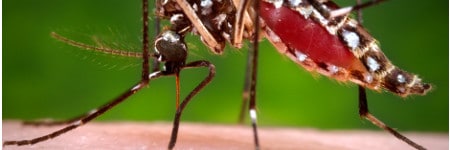Insect Repellent Safety

Protecting workers from mosquito bites can prevent diseases.
The safe use of insect repellents is an important way to prevent mosquito bites.
Employers should provide workers with repellents to use on their skin and clothing. Employers should:
- Provide training about the safe use of insect repellents.
- Provide Environmental Protection Agency (EPA)-registered insect repellentsexternal icon with one of the active these ingredients: DEET, picaridin (known as KBR 3023 and icaridin outside the US), IR3535, oil of lemon eucalyptus (OLE), para-menthane-diol (PMD), or 2-undecanone.
- Provide permethrin to be applied to clothing and gear. Permethrin should never be applied to the skin.
Workers should consistently and safely use insect repellents to decrease their risk of mosquito bites:
- Use EPA-registered insect repellentsexternal icon with one of the active these ingredients: DEET, picaridin (known as KBR 3023 and icaridin outside the US), IR3535, oil of lemon eucalyptus (OLE), para-menthane-diol (PMD), or 2-undecanone.
- Find the right insect repellent for you by using EPA’s search toolexternal icon.
- When used as directed, EPA-registered insect repellents are proven safe and effective, even for pregnant and breastfeeding women.
- Carefully follow label directions for repellent use and reapplication.
- Do not use repellent under clothing or on skin that is injured or irritated.
- Do not apply pump or aerosol products directly to the face. Instead, spray these products onto the hands and carefully rub them over the face, avoiding the eyes and mouth.
- If also applying sunscreen, apply sunscreen first and insect repellent second.
- Use permethrin products on clothing and gear as directed; do not apply them directly to skin.
- Permethrin products may be effective after several washings
-
NIOSH Fast Facts: Protecting Yourself from Ticks and Mosquitoespdf icon
Print or order this free card for easy access to important safety information. -

CDC Protection Against Mosquitoes, Ticks, and Other Arthropods
CDC has evaluated information published in peer-reviewed scientific literature and data available from EPA to identify several types of EPA-registered products that provide repellent activity sufficient to help people reduce the bites of disease-carrying mosquitoes. -

US EPA Find the Insect Repellent that is Right for Youexternal icon
A search tool to help you choose the repellent that is right for you. -

US EPA Insect Repellents: Reducing Insect bitesexternal icon
General guidance about insect repellents and tips to prevent mosquito bites.

